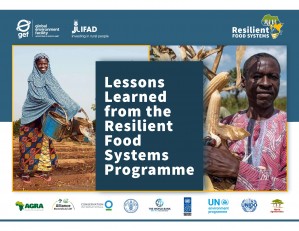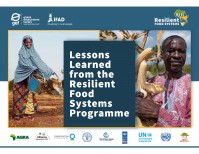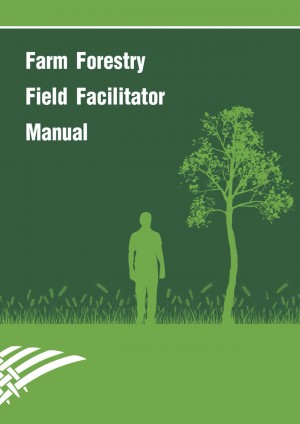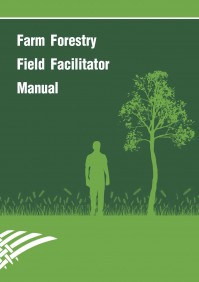Support from traditional leaders moves mountains in eSwatini
29 September 2022
World Agroforestry defines agroforestry as the interaction of agriculture and trees, including the agricultural use of trees. It is a dynamic natural resource management system that aims to produce trees for timber, to supply diverse and nutritious foods, and to ensure the protection of the natural environment. Reforestation restores degraded forests to the original state.
In Africa, the demand for food to feed rapidly growing populations is increasing the demand for arable land, leading to direct competition between the agriculture sector and Africa’s woodland and forest areas. Climate change and extreme weather events further impact the productivity of agricultural land, pushing farmers onto previously forested land in order to meet the food and energy needs of their communities.
As demand for food increases, smallholder farmers are not only expanding land under agricultural production, but are intensifying unsustainable agricultural practices in order to meet demand. These practices ultimately lead to land degradation and declining soil health – it is estimated that 65% of arable land, 30% of grazing land and 20% of forests in Africa are degraded. This current pattern perpetuates a vicious cycle whereby soils become less productive, forcing smallholders to continue to expand into forested land in search of arable land, which leads to further degradation, loss of essential ecosystem services, a decline in agricultural productivity, and a loss of carbon sinks.
In order to counteract the negative impacts of deforestation, the RFS programme promotes agroforestry and reforestation interventions as critical components in achieving food and nutrition security and contributing to global environment benefits. Integrating trees into agricultural landscapes and planning land use around forest ecosystems restores degraded land by increasing soil fertility, controlling erosion, improving soil water retention, and improve ground water quality.
In addition to improving crop yields, the rehabilitation and planting of forests provides local communities with access to diversified food and non-food products that contribute to food nutrition and security and generate new streams of income. When it comes to climate change mitigation, agroforestry and reforestation improve carbon sequestration while reducing agricultural contributions to carbon emissions. The rehabilitation and planting of forests also reduces the vulnerability of communities to climate change and increases the resilience of communities to climate shocks.
RFS country projects are implementing a variety of agroforestry and reforestation activities, including tree planting, installing efficient cookstoves, contour planting, hedgerow intercropping, and the promotion of non-timber forest product value chains.
In Burundi, a country that lost 5% of its forest cover between 2001 and 2019, FAO is using the Farmer Field Schools to both raise awareness of the importance of forests and teach smallholder farmers agroforestry techniques, such as contour planting, to reduce soil erosion and improve soil health. In Burkina Faso, the RFS country project team is helping the Government of Burkina Faso to reach its Land Degradation Neutrality targets through promotion of agroforestry and support of forest farmers. In Ethiopia, RFS is helping local school environmental clubs plant tree seedlings within their school compounds while teaching students about the vital importance of forests.
Explore the RFS Country Projects to see more examples of how RFS countries are implementing Agroforestry & Reforestation activities.
Stories from the Field
Explore our stories from the field to learn more about how RFS country project teams are implementing activities related to the programmatic theme of Agroforestry & Reforestation.
Relevant resources
We have a growing library of reports, briefs, case studies, media, tools and guidelines. Explore all resources related to Agroforestry & Reforestation to get greater insight into our programme activities.


Integrated Approach Pilot (IAP) programmes were conceived as part of the Global Environment Facility (GEF) 2020 Strategy to test the delivery of integrated approaches that address discrete, timebound, complex, global environmental challenges. In its Sixth Replenishment Cycle (GEF6), three IAPs were funded: Sustainable Cities, Taking Deforestation out of Commodity Supply Chains, and Fostering Sustainability and Resilience for Food Security in Sub-Saharan Africa, also known as the Resilient Food Systems (RFS) programme.
The RFS programme serves as an outstanding example of different partners and countries with distinct mandates joining forces to pursue a shared objective, leveraging their respective strengths to transform food systems in Africa. It highlights the significance of clearly articulating the programme’s vision, establishing a well-defined division of labour, and delineating roles and responsibilities from the outset, forming the foundation for an accountability framework. Moreover, the RFS underscores the importance of adopting a nexus approach that integrates food security, agriculture, environment, socio-economic, and climate considerations.
This holistic approach recognizes the interconnectedness of these sectors and the need for holistic solutions. The RFS’s systems-based approach brings together multiple partners at different levels and fosters information flows in both directions, supporting collaboration and knowledge sharing.
This publication presents some of the main lessons learned from the RFS programme, which lasted for six years between 2017 and 2023. It provides a reflection on the implementation, lessons learned, and observations around the key components of the RFS. The programmatic value-add of the RFS and the manner with which it was harnessed during implementation is conveyed through case studies drawn from the experience of the country projects across these components.


Abstract
While attention has been paid largely to forest restoration, meeting global land restoration pledges will require scaling-up restoration of ecosystem services on agricultural land. This paper contributes to the literature on restoration practice and agricultural technology adoption, by shifting the focus onto the farm and considering the role of intrahousehold dynamics in the uptake of farmland restoration practices. We examine the intrahousehold decisions and gender relations surrounding the trial of two on-farm restoration practices: tree planting and planting basins; with over 2,500 farmers in the eastern drylands of Kenya. Combining results from household surveys, interviews and focus group discussions, our findings reveal that decisions over the uptake of restoration practices, although usually initiated by women who attend agricultural workshops, are often discussed between husband and wife and that multiple social dimensions intersect to shape men’s and women’s interest in, contribution to, and benefit from different practices. Furthermore, our study demonstrates that these intrahousehold relations are, in turn, shaped by women’s participation in innovation processes and broader societal changes, particularly the outmigration of rural men. Based on these insights, we offer recommendations for improving the dissemination and uptake of on-farm restoration practices in eastern Kenya and achieving more inclusive and gender-equitable outcomes.


The Danish Forestry Extension (DFE) works in partnership with local communities and local and international organisations to support the development of sustainable forest and natural resources management across the globe. DFE has been involved in establishing farmer field schools and developing training materials for farm forestry in Vietnam and Mozambique.
The field facilitator manual, developed together with the North Vietnam college of Agriculture and Rural Development, is a step by step guide for newly trained field facilitators on establishing and running farmer field schools for farm forestry. The manual is divided into 30 sessions, and includes details on closing ceremonies for FFS and facilitator notes.